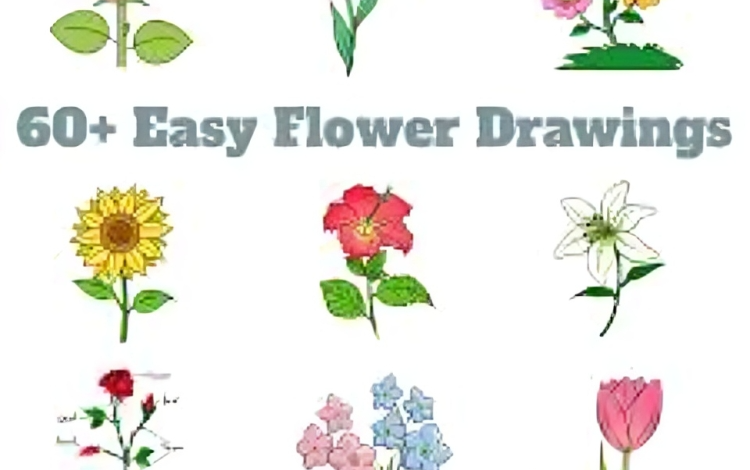Simple Flower Drawings Easy Ideas for Beginners and Art Enthusiasts

Drawing flowers is one of the most rewarding and accessible ways to start exploring the world of art. Whether you’re a beginner looking to pick up a pencil for the first time or an experienced artist seeking to enhance your portfolio, simple flower drawings offer a perfect balance between creativity and ease. With minimal tools and basic techniques, you can create beautiful designs that capture the charm and elegance of nature. This article explores simple flower drawing ideas, step-by-step instructions, and helpful tips to guide you along your artistic journey.
Why Draw Simple Flowers?
Flowers are some of the most captivating subjects to draw. Their delicate structure, vibrant colors, and graceful forms make them universally loved in art. But why start with simple flower drawings? Here are a few reasons why:
- Easy to Learn: Flowers come in many shapes, sizes, and styles, but they generally follow basic geometric principles. Starting with simple designs helps you build foundational skills in sketching, shading, and proportion.
- Relaxing and Therapeutic: Drawing flowers can be a calming activity. The repetitive motion of sketching petals or leaves can promote mindfulness and relaxation.
- Creative Expression: Once you get the basics down, you can experiment with various flower types, textures, and colors, allowing your creativity to flow freely.
- Great for Decorating: Simple flower drawings can be used to decorate anything from notebooks to greeting cards, home walls, and more. They’re versatile and easy to incorporate into your personal style.
Materials You’ll Need for Drawing Simple Flowers
Before you dive into creating your own flower sketches, it’s important to have a few basic materials ready. Fortunately, creating simple flower drawings doesn’t require much. Here’s what you’ll need:
- Pencil: A good-quality graphite pencil, ideally with a range of hardness (HB for light sketching and 2B for darker lines).
- Paper: Any plain, smooth paper will work, though sketchbooks are ideal for drawing practice.
- Eraser: A soft eraser is essential for correcting mistakes or lightening certain areas.
- Colored Pencils or Markers (optional): If you want to add color, colored pencils or markers will help bring your flowers to life.
- Ruler (optional): If you want to ensure symmetry, a ruler can be useful, though it’s not strictly necessary for freehand drawings.
Step-by-Step Guide to Drawing Simple Flowers
Now, let’s look at how you can draw a variety of simple flowers, starting with the basics. This section will walk you through step-by-step instructions for creating some easy flower drawings.
1. Drawing a Simple Daisy
Daisies are one of the easiest flowers to draw because of their symmetrical petals and simple shape. Here’s how to draw one:
Step 1: Start by drawing a small circle in the center of your page. This will form the center of the daisy.
Step 2: Draw five or six elongated oval shapes around the circle. These ovals will be the daisy’s petals. Make sure they are evenly spaced around the center.
Step 3: Add small lines within the circle to give texture and detail to the center of the flower.
Step 4: Lightly sketch the outline of the flower stem. You can make the stem straight or slightly curved.
Step 5: Add a couple of leaves at the bottom of the stem. They should be simple oval shapes with pointed tips.
Step 6: Outline the drawing with a dark pencil or pen to give it definition, and add shading to the petals to give them depth.
Step 7: (Optional) Color the petals white and the center yellow, or use colors of your choice to bring the daisy to life.
2. Drawing a Simple Rose
Roses may seem complicated, but with the right approach, you can create a beautiful and simple version of this classic flower.
Step 1: Start with a small spiral in the center of your page. This spiral will form the innermost petal of the rose.
Step 2: Draw a few more curved lines around the spiral to represent additional petals. Each petal should curve outward and overlap the previous one.
Step 3: Continue adding petals, making each one a little larger and curvier than the last.
Step 4: Draw the stem extending downward from the base of the rose. You can make the stem as long or short as you like.
Step 5: Add two or three leaves at the base of the stem. Rose leaves have jagged edges, so draw them with sharp, angular shapes.
Step 6: Go over your lines to make them bold and distinct. You can add some light shading to the petals to create the illusion of depth and softness.
Step 7: (Optional) Color the petals red, pink, or yellow, and shade the leaves with green for a more realistic look.
3. Drawing a Simple Tulip
Tulips are another flower that’s relatively easy to sketch due to their simple shape and clean lines. Here’s how to draw one:
Step 1: Start by drawing an upside-down “U” shape at the top of your page. This will form the basic outline of the tulip’s petals.
Step 2: Draw two more “U” shapes on either side of the first one, slightly overlapping. This creates the tulip’s three main petals.
Step 3: Add a small, rounded shape at the bottom of the tulip to form the base.
Step 4: Sketch two long, straight lines extending down from the base of the tulip for the stem.
Step 5: Add one or two long, narrow leaves along the stem. Tulip leaves have a sharp, pointed shape.
Step 6: Trace over your drawing with darker lines to finalize the details, and add shading at the base of the petals to make the tulip look more dimensional.
Step 7: (Optional) Color the tulip in vibrant shades of red, yellow, purple, or pink, and color the leaves green.
4. Drawing a Simple Lily
Lilies are known for their elegant, trumpet-shaped petals. Their simplicity in structure makes them a great flower to practice drawing.
Step 1: Start by drawing a small oval shape for the base of the lily’s petals.
Step 2: From the oval, draw three long, curved lines extending outward. These will be the main petals of the lily.
Step 3: Add three more smaller petals between the first set, slightly overlapping the larger petals.
Step 4: Draw a thin, long stem extending downward from the base of the petals.
Step 5: Add one or two slender leaves extending from the stem. Lily leaves are usually long and narrow.
Step 6: Outline your drawing with a dark pencil or pen and add some shading to the petals to create a sense of depth and texture.
Step 7: (Optional) Color the petals in soft shades of white, pink, or orange, and use green for the leaves and stem.
Tips for Enhancing Your Simple Flower Drawings
While simple flower drawings are great for beginners, you can enhance them with these helpful tips:
- Vary the Shapes: Experiment with different petal shapes, such as rounded, pointed, or heart-shaped, to give each flower a unique personality.
- Practice Proportions: Pay attention to the size relationships between the flower’s center, petals, and stem. This will make your drawings look more natural and realistic.
- Shading for Depth: Use soft shading techniques to add depth and dimension to your flowers. Pay attention to where light would naturally hit the petals to create contrast.
- Use Color Wisely: While many flowers are beautiful in natural colors, don’t be afraid to experiment with vibrant or unusual hues to make your flowers stand out.
- Work on Symmetry: Flowers are often symmetrical, but slight imperfections in symmetry can make your drawings feel more organic and real.
- Add Details: Small details like veins in the petals, pollen in the center, or water droplets on the leaves can take your drawing to the next level.
Conclusion
Simple Flower Drawings is an enjoyable and creative way to hone your artistic skills. Whether you’re a beginner or looking to practice more intricate designs, the tips and steps outlined in this article can help guide you through the process. Remember, the beauty of flowers lies in their diversity, so don’t hesitate to experiment with different shapes, colors, and compositions. Most importantly, have fun and enjoy the process of creating art that’s as beautiful as the flowers themselves!




